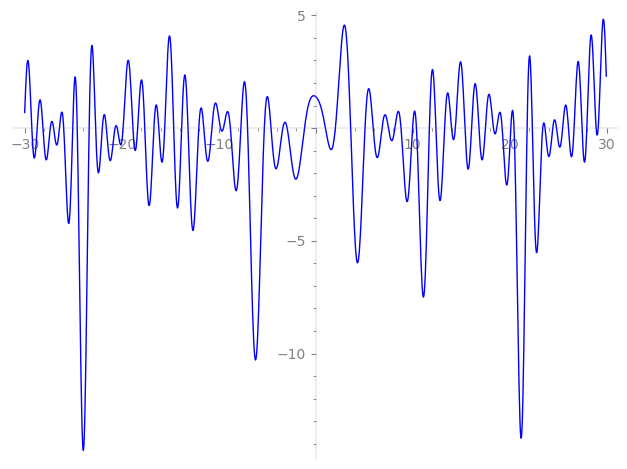| L(s) = 1 | + (−0.831 − 1.14i)2-s + (0.618 + 1.90i)3-s + (−0.618 + 1.90i)4-s + (1.66 − 2.28i)6-s + (2.68 − 0.874i)8-s + (−0.809 + 0.587i)9-s − 3.99·12-s + (−3.23 − 2.35i)16-s + (3.32 − 4.57i)17-s + (1.34 + 0.437i)18-s + (8.06 − 2.62i)19-s + (3.32 + 4.57i)24-s + (1.54 + 4.75i)25-s + (3.23 + 2.35i)27-s + 5.65i·32-s + ⋯ |
| L(s) = 1 | + (−0.587 − 0.809i)2-s + (0.356 + 1.09i)3-s + (−0.309 + 0.951i)4-s + (0.678 − 0.934i)6-s + (0.951 − 0.309i)8-s + (−0.269 + 0.195i)9-s − 1.15·12-s + (−0.809 − 0.587i)16-s + (0.806 − 1.10i)17-s + (0.317 + 0.103i)18-s + (1.85 − 0.601i)19-s + (0.678 + 0.934i)24-s + (0.309 + 0.951i)25-s + (0.622 + 0.452i)27-s + 0.999i·32-s + ⋯ |
Λ(s)=(=(968s/2ΓC(s)L(s)(0.958−0.286i)Λ(2−s)
Λ(s)=(=(968s/2ΓC(s+1/2)L(s)(0.958−0.286i)Λ(1−s)
| Degree: |
2 |
| Conductor: |
968
= 23⋅112
|
| Sign: |
0.958−0.286i
|
| Analytic conductor: |
7.72951 |
| Root analytic conductor: |
2.78020 |
| Motivic weight: |
1 |
| Rational: |
no |
| Arithmetic: |
yes |
| Character: |
χ968(723,⋅)
|
| Primitive: |
yes
|
| Self-dual: |
no
|
| Analytic rank: |
0
|
| Selberg data: |
(2, 968, ( :1/2), 0.958−0.286i)
|
Particular Values
| L(1) |
≈ |
1.38023+0.201819i |
| L(21) |
≈ |
1.38023+0.201819i |
| L(23) |
|
not available |
| L(1) |
|
not available |
L(s)=p∏Fp(p−s)−1 | p | Fp(T) |
|---|
| bad | 2 | 1+(0.831+1.14i)T |
| 11 | 1 |
| good | 3 | 1+(−0.618−1.90i)T+(−2.42+1.76i)T2 |
| 5 | 1+(−1.54−4.75i)T2 |
| 7 | 1+(−5.66−4.11i)T2 |
| 13 | 1+(4.01−12.3i)T2 |
| 17 | 1+(−3.32+4.57i)T+(−5.25−16.1i)T2 |
| 19 | 1+(−8.06+2.62i)T+(15.3−11.1i)T2 |
| 23 | 1−23T2 |
| 29 | 1+(−23.4−17.0i)T2 |
| 31 | 1+(−9.57+29.4i)T2 |
| 37 | 1+(29.9+21.7i)T2 |
| 41 | 1+(10.7−3.49i)T+(33.1−24.0i)T2 |
| 43 | 1−8.48iT−43T2 |
| 47 | 1+(38.0−27.6i)T2 |
| 53 | 1+(−16.3+50.4i)T2 |
| 59 | 1+(1.85−5.70i)T+(−47.7−34.6i)T2 |
| 61 | 1+(18.8+58.0i)T2 |
| 67 | 1−14T+67T2 |
| 71 | 1+(−21.9−67.5i)T2 |
| 73 | 1+(16.1+5.24i)T+(59.0+42.9i)T2 |
| 79 | 1+(24.4−75.1i)T2 |
| 83 | 1+(−1.66+2.28i)T+(−25.6−78.9i)T2 |
| 89 | 1−18T+89T2 |
| 97 | 1+(8.09−5.87i)T+(29.9−92.2i)T2 |
| show more | |
| show less | |
L(s)=p∏ j=1∏2(1−αj,pp−s)−1
Imaginary part of the first few zeros on the critical line
−9.812485814054689917506477541590, −9.510776758998169859136161456581, −8.795900215282151910972457928209, −7.71535688597177114058285562389, −7.02642726856748999922570370698, −5.29938131556421681876797322014, −4.60747256774488109939658552174, −3.39137474446855105255960182977, −2.94581417892924263598829772378, −1.15886717318384733764948724713,
0.999877725211212414818740559137, 2.02435868604398995908738758780, 3.60187525345255533036264675113, 5.08060657767811712694530541479, 5.92364350865537645902763071413, 6.83250805199909928764923346610, 7.49789368704775662339885992421, 8.160169577003454342218514473197, 8.793239240651029431098835156546, 9.983306128581646517250115318379

